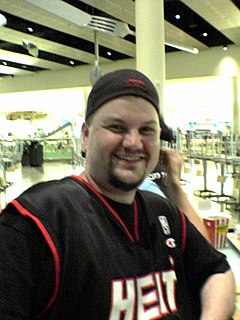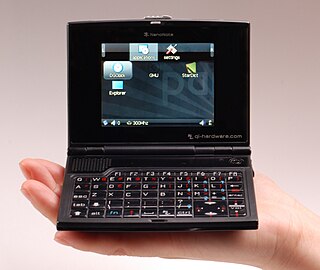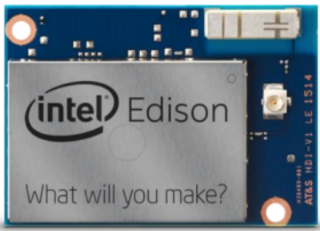
Jeri Janet Ellsworth is an American entrepreneur, computer chip designer and inventor. She gained fame in 2004 for creating a complete Commodore 64 emulator system on a chip housed within a joystick, called Commodore 30-in-1 Direct to TV. It runs 30 video games from the 1980s, and at peak, sold over 70,000 units in a single day via the QVC shopping channel.

David Blake, also known as StankDawg, is the founder of the hacking group Digital DawgPound (DDP) and a long-time member of the hacking community. He is known for being a regular presenter at multiple hacking conferences, but is best known as the creator of the "Binary Revolution" initiative, including being the founding host and producer of Binary Revolution Radio, a long-running weekly Internet radio show which ran 200 episodes from 2003 to 2007.

PlayStation Portable homebrew refers to the process of using exploits and hacks to execute unsigned code on the PlayStation Portable (PSP).

Joystiq was a video gaming blog founded in June 2004 as part of the Weblogs, Inc. family of weblogs, now owned by AOL. It was AOL's primary video game blog, with sister blogs dealing with MMORPG gaming in general and the popular MMORPG World of Warcraft in particular.
Weblogs, Inc. was a blog network that published content on a variety of subjects, including tech news, video games, automobiles and pop culture. At one point, the network had as many as 90 blogs, although the vast majority of its traffic could be attributed to a smaller number of breakout titles, as was typical of most large-scale successful blog networks of the mid-2000s. Popular blogs included: Engadget, Autoblog, TUAW, Joystiq, Luxist, Slashfood, Cinematical, TV Squad, Download Squad, Blogging Baby, Gadling, AdJab, and Blogging Stocks.

Jason McCabe Calacanis is an American Internet entrepreneur, angel investor, author and podcaster.
The Digital DawgPound is a group of hackers, best known for a series of articles in hacker magazines such as 2600: The Hacker Quarterly and Make, the long-running webcast Binary Revolution Radio, and a very active set of forums with posts from high-profile hackers such as Strom Carlson, decoder, Phiber Optik and StankDawg. The stated mission of the DDP is to propagate a more positive image of hackers than the negative mass media stereotype. The group welcomes new members who want to learn about hacking, and attempts to teach them more positive aspects and steer them away from the negative aspects, by reinforcing the hacker ethic. Their goal is to show that hackers can, and regularly do, make positive contributions not only to technology, but to society as a whole.

Andrew "bunnie" Huang is an American researcher and hacker, who holds a Ph.D in electrical engineering from MIT and is the author of the freely available 2003 book Hacking the Xbox: An Introduction to Reverse Engineering. As of 2012 he resides in Singapore. Huang is a member of the Zeta Beta Tau fraternity, and a resident advisor and mentor to hardware startups at HAX, an early stage hardware accelerator and venture capital firm.

ioBridge is a manufacturer of Internet-based monitor and control hardware and a provider of seamlessly integrated cloud-based social Web 2.0 folksonomies and curated online API webservices, using WebSocket, JSON and a host of other related technologies.

The maker culture is a contemporary subculture representing a technology-based extension of DIY culture that intersects with hardware-oriented parts of hacker culture and revels in the creation of new devices as well as tinkering with existing ones. The maker culture in general supports open-source hardware. Typical interests enjoyed by the maker culture include engineering-oriented pursuits such as electronics, robotics, 3-D printing, and the use of computer numeric control tools, as well as more traditional activities such as metalworking, woodworking, and, mainly, its predecessor, traditional arts and crafts.

Limor Fried is an American electrical engineer and owner of the electronics hobbyist company Adafruit Industries. She is influential in the open-source hardware community, having participated in the first Open Source Hardware Summit and the drafting of the Open Source Hardware definition, and is known by her moniker ladyada, an homage to Lady Ada Lovelace.
Cemetech is a programming and hardware development group and developer community founded in 2000. Its primary software focus is calculator programming for TI and Casio graphing calculators, and its primary hardware focus is on mobile and wearable computing hardware. Among its most notable projects are the Doors CS shell for the TI-83+ series of graphing calculators, the Clove 2 dataglove, the Ultimate Calculator, and the CALCnet / globalCALCnet system for networking graphing calculators and connecting them to the Internet. The Cemetech website hosts tools for calculator programmers, including the SourceCoder TI-BASIC IDE and the jsTIfied TI-83+/84+ emulator. The founder of the site, Dr. Christopher Mitchell, began the site to showcase his personal projects, but since its early days, it has branched out to become one of the several major sites of the TI calculator hobbyist community and a source for hardware and programming development assistance. It has incubated many software and hardware projects beginning in the calculator community at its roots but including microprocessor development, general electrical engineering, desktop applications, and mobile/web applications.

The Ben NanoNote is a pocket computer using the Linux-based OpenWrt operating system. An open-source hardware device developed by Qi Hardware, it has been called possibly "the world's smallest Linux laptop for the traditional definition of the word.". In addition, the Ben NanoNote is noteworthy for being one of the few devices on the market running entirely on copyleft hardware.

Chromecast is a line of digital media players developed by Google. The devices, designed as small dongles, can play Internet-streamed audio-visual content on a high-definition television or home audio system. The user controls playback with a mobile device or personal computer through mobile and web apps that support the Google Cast protocol, or by issuing commands via Google Assistant. Alternatively, content can be mirrored from the Google Chrome web browser on a personal computer or from the screen of some Android devices.

The Intel Edison is a computer-on-module that was offered by Intel as a development system for wearable devices and Internet of Things devices. The system was initially announced to be the same size and shape as an SD card and containing a dual-core Intel Quark x86 CPU at 400 MHz communicating via Bluetooth and Wi-Fi. A later announcement changed the CPU to a 500 MHz Silvermont dual-core Intel Atom CPU, and in September 2014 a second version of Edison was shown at IDF, which was bigger and thicker than a standard SD card.

littleBits is a New York City-based startup that makes an open source library of modular electronics, which snap together with small magnets for prototyping and learning. The company's goal is to democratize hardware the way software and printing have been democratized. The littleBits mission is to "put the power of electronics in the hands of everyone, and to break down complex technologies so that anyone can build, prototype, and invent." littleBits units are available in more than 70 countries and used in more than 2,000 schools. The company was named to CNN's 10 Startups to Watch for 2013.

The Prusa i3 series consists of open-source fused deposition modeling 3D printers, manufactured by Czech company Prusa Research under the trademarked name Original Prusa i3. Part of the RepRap project, Prusa i3 printers were named the most used 3D printer in the world. The first Prusa i3 was designed by Josef Průša in 2012, and was released as a commercial kit product in 2015. The latest model is available in both kit and factory assembled versions. The Prusa i3's comparable low cost and ease of construction and modification has made it popular in education and with hobbyists and professionals. Since the i3 series is open source, there have been many variants produced by companies and individuals worldwide.

FarmBot is an open source precision agriculture CNC farming project consisting of a Cartesian coordinate robot farming machine, software and documentation including a farming data repository. The project aims to "Create an open and accessible technology aiding everyone to grow food and to grow food for everyone." FarmBot is an open source project allowing hardware, software and documentation modifications and additions from users.

Naomi Wu, also known as Sexy Cyborg, is a Chinese DIY maker and internet personality. As an advocate of women in STEM, transhumanism, open source hardware, and body modification, she attempts to challenge gender and tech stereotypes with a flamboyant public persona, using objectification of her appearance to inspire women.
Osmocom is an open-source software project that implements multiple mobile communication standards, including GSM, DECT, TETRA and others.
















